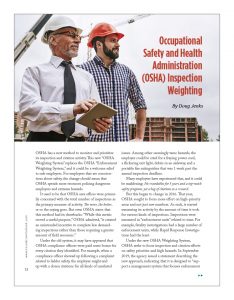Occupational Safety and Health Administration (OSHA) Inspection Weighting
OSHA has a new method to monitor and prioritize its inspection and citation activity. This new “OSHA Weighting System” replaces the OSHA “Enforcement Weighting System,” and it could be a welcome relief to safe employers. For employers that are conscientious about safety, the change should mean that OSHA spends more resources policing dangerous employers and extreme hazards.
It used to be that OSHA area offices were primarily concerned with the total number of inspections as the primary measure of activity. The more, the better, or so the saying goes. But even OSHA states that this method had its drawbacks: “While this metric served a useful purpose,” OSHA admitted, “it created an unintended incentive to complete less demanding inspections rather than those requiring a greater amount of field resources.”
Under the old system, it may have appeared that OSHA compliance officers were paid some bonus for every citation they identified. For example, when a compliance officer showed up following a complaint related to ladder safety, the employer might end up with a dozen citations for all kinds of unrelated issues. Among other seemingly tame hazards, the employer could be cited for a fraying power cord, a flickering exit light, debris in an aisleway, and a portable fire extinguisher that was 1 week past the annual inspection deadline.
Many employers have experienced that, and it could be maddening: No recordables for 5 years and a top-notch safety program, yet a bag of citations as a reward.
But this began to change in 2016. That year, OSHA sought to focus more effort on high-priority areas and not just raw numbers. As such, it started measuring its activity by the amount of time it took for various kinds of inspections. Inspections were measured in “enforcement units” related to time. For example, fatality investigations had a large number of enforcement units, while Rapid Response Investigations had the least.
Under the new OSHA Weighting System, OSHA seeks to focus inspection and citation efforts on safety priorities and high hazards. In September 2019, the agency issued a statement describing the new approach, indicating that it is designed to “support a management system that focuses enforcement activities on critical and strategic areas where the agency’s efforts can have the most impact.”
That does not necessarily mean that OSHA will no longer pile on the citations for seemingly minor transgressions, but it does mean that OSHA will be more oriented to significant workplace hazards. “The new system will continue to weight inspections,” OSHA stated, “but will do so based on other factors, including agency priorities and the impact of inspections, rather than simply on a time-weighted basis.”
As such, the new system will reportedly focus more attention on the construction industry’s “Fatal Four” hazards: electrocution, fall, struck-by, and caught-in and between hazards. These 4 hazards account for roughly 60% of all workplace deaths and will receive 3 enforcement units, unless they are part of a criminal case or fatality. Criminal cases will receive 7 enforcement units, and fatalities will receive 5. Heat, ergonomic, and workplace violence hazards will each receive 2.
It remains to be seen whether this new weighting system will result in more or fewer inspections and citations, but one thing is clear: Investing in safety pays dividends. Employers with solid safety programs, including training and enforcement, have fewer workplace injuries. This will keep OSHA at bay and employees productive and healthy. So regardless of how OSHA prioritizes its activities, employers should always prioritize safety.
Copyright statement
This article was published in the January 2020 issue of Insulation Outlook magazine. Copyright © 2020 National Insulation Association. All rights reserved. The contents of this website and Insulation Outlook magazine may not be reproduced in any means, in whole or in part, without the prior written permission of the publisher and NIA. Any unauthorized duplication is strictly prohibited and would violate NIA’s copyright and may violate other copyright agreements that NIA has with authors and partners. Contact publisher@insulation.org to reprint or reproduce this content.
Disclaimer: Unless specifically noted at the beginning of the article, the content, calculations, and opinions expressed by the author(s) of any article in Insulation Outlook are those of the author(s) and do not necessarily reflect the views of NIA. The appearance of an article, advertisement, and/or product or service information in Insulation Outlook does not constitute an endorsement of such products or services by NIA. Every effort will be made to avoid the use or mention of specific product brand names in featured magazine articles.

